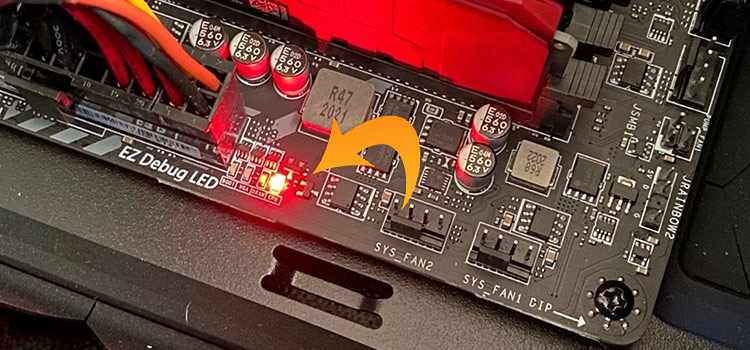What Does a Wi-Fi Motherboard Do? How Beneficial to have Wi-Fi Motherboard?
The question that has been asked by many people is what does a Wi-Fi motherboard do? If you are also not familiar with the Wi-Fi motherboard, then don’t worry, we are here to help you.
This article will tell you about the Wi-Fi motherboard and will also be able to differentiate between Wi-Fi and non-Wi-Fi motherboards by end of this article. Till then stay with us.

What Is a Wi-Fi Motherboard and What Does It Do?
A motherboard of a computer that has a built-in 802.11 Wi-Fi circuit soldered in it is known as the Wi-Fi motherboard. This Wi-Fi circuitry allows users to connect to the internet wirelessly. Most laptops and some desktop motherboards have Wi-Fi chipset preinstalled.
If a computer has a Wi-Fi motherboard, then you will be able to use the internet without any external adapter or wire.
Difference Between Wi-Fi & Non-Wi-Fi Motherboards
As you already learned from the previous article that a Wi-Fi motherboard has a Wi-Fi card attached to the board from the beginning and a non-Wi-Fi motherboard doesn’t come equipped with any Wi-Fi chipset or circuitry. So, you cannot use the internet wirelessly using a non-Wi-Fi motherboard.
Apart from that, a Wi-Fi motherboard gives portability to its user whereas a non-Wi-Fi motherboard doesn’t.
For example, you can use your laptop anywhere in your house while connected to Wi-Fi, and conversely, you have you use a wired connection on your desktop which has a non-Wi-Fi motherboard. So, you cannot have the freedom to use that desktop anywhere in your house unless you have run the ethernet cable along all the rooms.
Merits and Demerits of a Wi-Fi Motherboard
If you are willing to buy a Wi-Fi motherboard then first, you will need to know its benefits and limitations of it. So, here we have provided the benefits and limitations of a Wi-Fi motherboard. Hope it will help you to choose whether you should buy it or not.
Benefits of Wi-Fi Motherboard:
There are several benefits of having a Wi-Fi motherboard on your computer which are listed below:
1. No External Adapters
A Wi-Fi motherboard has a built-in Wi-Fi feature. So, you don’t need to use any external Wi-Fi adapter to use the internet wirelessly.
2. No Wire
As a Wi-Fi motherboard let you use the internet wirelessly, you don’t need any cable to connect to the internet. However, if you want to use a wired connection, then the Wi-Fi motherboard will let you use an ethernet cable also.
3. Bluetooth Feature
The Bluetooth feature is directly connected to the Wi-Fi chipset. If a motherboard has built-in Wi-Fi, then it also will have Bluetooth capabilities. You cannot use Bluetooth with a non-Wi-Fi motherboard.
4. Multiple Connection
The Wi-Fi motherboard will allow you to connect to the internet in multiple ways such as wired and wireless at the same time.
Limitations of Wi-Fi Motherboard:
1. Unable to Replace
As the Wi-Fi chip is soldered to the board in Wi-Fi motherboards, so if the chip is damaged or broken then it is unable to replace except by de-soldering it.
2. Affect Bluetooth Feature
As the Wi-Fi motherboard is connected to the Bluetooth feature, if the hardware stop working, or you disable the Wi-Fi feature, then the computer will also lose Bluetooth capability.
3. Compatibility with the Wireless
If the soldered wireless chip of the Wi-Fi motherboard is incompatible with your home Wi-Fi, then it may transmit the internet data at a lower speed than others.
Frequently Asked Questions
Is Wi-Fi Motherboard Necessary?
No, a Wi-Fi motherboard isn’t a mandatory thing because there are a few alternative ways to use the internet on a non-Wi-Fi motherboard. You can still use the internet wirelessly using a Wi-Fi adapter on a non-Wi-Fi motherboard.
Should I Buy a Wi-Fi Motherboard?
It completely depends on your need. You can indeed use the internet wirelessly using an adapter on a non-Wi-Fi motherboard. But if you buy a Wi-Fi motherboard, then you don’t need to take any hassle to use an external adapter.
Do All PC Have Wi-Fi Motherboard?
No, all PCs don’t come equipped with built-in Wi-Fi on the motherboard. TH older model PCs contain non-Wi-Fi motherboards. However, new model PCs are providing Wi-Fi motherboards with so many modern features.
Why All Motherboards Don’t Have Built-In Wi-Fi?
This feature gives users the flexibility and portability of using the internet anywhere and at any time. But the problem is, Wi-Fi motherboards are more costly than a non-Wi-Fi motherboard. So, everyone may not have the ability to buy motherboards at a higher cost. On the other hand, many users prefer a wired connection instead of Wi-Fi because of its stability and speed. That’s why not all motherboards have built-in Wi-Fi.
How Do I Use Wi-Fi on My Non-Wi-Fi Motherboard?
If your motherboard doesn’t have a built-in Wi-Fi chip, then there are two options in your hand to use the internet wirelessly on your computer. You can either add a Wi-Fi card to your motherboard on the Extension card slot, or you can use USB Wi-Fi dongles to connect your PC to the Wi-Fi.
Conclusion
On the whole, a Wi-Fi motherboard is a fabulous addition to any computer. It not only allows you to connect to the internet but also gives Bluetooth compatibility to the computer. As the internet is one of the basic needs in our daily life, the Wi-Fi motherboard is the best option if you consider buying a motherboard for your computer. If you have any further questions, then feel free to ask in our comment section below. Thanks for reading.
Subscribe to our newsletter
& plug into
the world of technology





